Antique cribbage board
Tripp's Mt. Juneau Trading Post | walrus ivory with baleen rail | made in Alaska c. 1950s




Cribbage, Curios, and the Commercialization of Culture
Indigenous Reclamation the of the Souvenir Trade
$1565, in June 2022, fetches you an “Antique cribbage board. Circa 1950s. Made from walrus ivory with baleen rail. Made in Alaska.” (Tripp’s Mount Juneau Trading Post 2022). Displayed alongside Tlingit drums, soapstone sculptures, and Alaskan Ulu knives, the online site of Tripp’s Mount Juneau Trading Post nearly calls to mind the negative implications of the displays of the Ye Olde Curiosity Shoppe. The artifacts are eclectic, the website’s design leans into totemic Tlingit imagery, and the conclusions could be problematic. Except that this store is owned and operated by a Tlingit family: “It is our mission to support Indigenous artists throughout the state of Alaska and of the northwest coast of Canada. We work to nurture the artistic talents of both the young and old. It is our hope that through representation of this art, we strengthen the culture and heritage of our people. Every item in the Mt. Juneau Trading Post is individually hand selected to ensure outstanding quality, workmanship, and distinction.”
In the 1880s and 1890s, ivory carving “morphed from subsistence into a cash enterprise,” notes scholar Michael Englehard (Englehard 2018). By the 2000s, that enterprise has taken the form of family-run flagship stores with online websites. The prices are high, and Alaskan Native makers and sellers have a monopoly on ivory products thanks to Alaskan law. Ivory cribbage boards are still created and purchased, and the middle-man of the white-owned curiosity shop or the museum collector has been circumvented.
To be sure, this cribbage board and others sold today still incorporate “modified old engraving” styles – maintaining the western pictorialization first adopted in the late 19th-century. Whether this represents the loss of traditional etching or emphasizes the adaptable skills of Indigenous artisans, though, is subjective.
In general, the sale of the ivory cribbage board, which might alternately – in other times, in other settings, especially – be read as a site of colonial imposition, seems, in this case, to be a site of attempted agency. Through the proliferation of Tlingit-made goods and through an emphasis on other, more traditional objects (the cribbage board is not prominently displayed), this store works to reclaim the colonial origins of the souvenir trade to support Indigenous artists, spread visibility of Alaskan Native artwork and traditional material culture, and stake ownership over on a practice that has been commercialized, collected, and dictated by white people for decades.
References
Engelhard, Michael. "Working the Ocean's White Gold." Alaska, 10, 2018: 48-49. https://www.proquest.com/magazines/working-oceans-white-gold/docview/2112526494/se-2?accountid=10422.
Tripps Mount Juneau Trading Post. “Cribbage Board.” Tripps Mount Juneau Trading Post. Retrieved June 4, 2022: https://mtjuneautradingpost.com/proddetail.php?prod=SCRIM2D